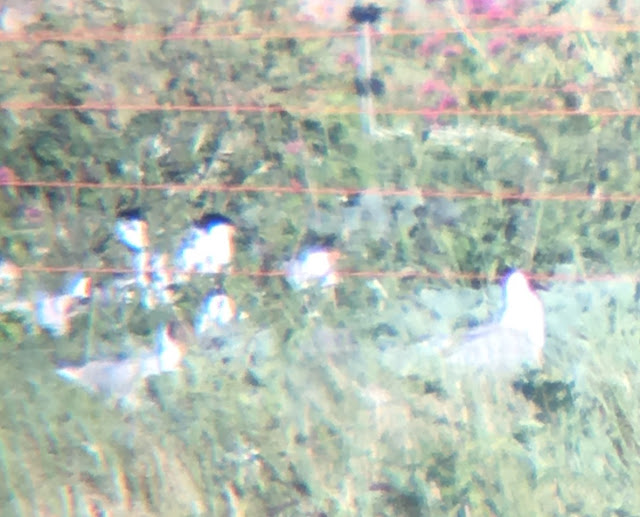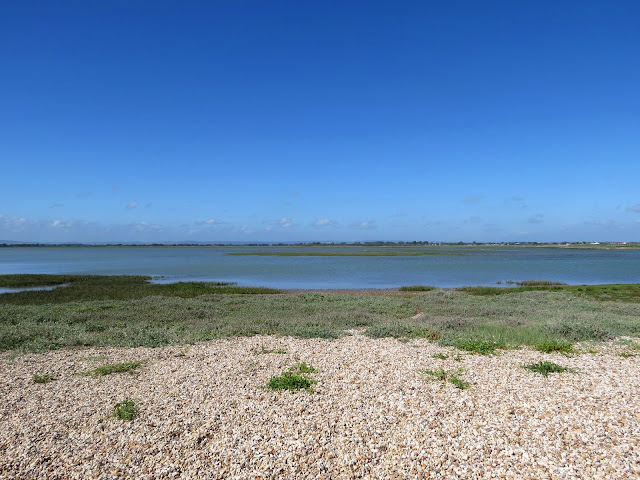After a relatively poor spring in terms of mega migrants, we thought a trip up to Glasgow so Alex could attend a concert would hopefully not result in us missing anything major on the birding scene…. We should really have known better, as right on cue with just 3 days to go after a spring of silence, it seemed the fates were against us and the birding Gods were punishing our naivety as the mega alerts wailed in to action **MEGA – Elegant Tern in Hampshire!!**
Pulses racing, our excitement was short lived as in the brief hour the Elegant Tern was present on the sandy spit at Hayling Island, only 6 observers managed to connect with it before it flew off out to sea, with nothing further until the Friday night when it was seen flying off towards West Sussex late afternoon after a 10 minute visit to Sandy Point.
Thinking it was unlikely to be pinned down to a site and with many of the Sandwich Tern colonies along the Hampshire coast situated in inaccessible locations, the fact that the mega alerts went off once more signalling the Elegant Tern had been refound at Pagham Harbour in West Sussex 10 minutes before we were due to set off for Glasgow didn’t cause too much alarm, as it surely wouldn’t hang about long enough for the twitching masses to connect with, its departure 20 minutes later adding weight to our misplaced hopes.
How wrong we were, as the entire journey up to Glasgow and the evening therein after consisted of a constant stream of mega alerts telling us the tern was still present and showing well to its steadily increasing crowd of admirers, all happily ticking this potential first accepted record for Britain.
 |
| The Elegant Tern was a definite crowd bringer! |
There was only one thing for it, and with alarms set for 3:40am after a short snatch of sleep after the concert had finished, we were soon on our way back down a deserted M6 and heading for the south coast – a trip from Glasgow to Cheshire with the small matter of a diversion to West Sussex well underway!
465 miles and 8 hours later we arrived at the RSPB Pagham Harbour car park, the parking attendant’s walkie-talkie crackling in to life as he directed us to a parking spot informing us that the tern had just this second flown off – horrendous timing. However, with the Elegant Tern having developed a pattern of heading out to sea to fish for periods of time before returning to “Tern Island” to rest, we set off on the 30 minute walk to where the bird was spending its time hopeful that it would soon return.
 |
| Blue skies over Pagham Harbour |
 |
| Plenty of Sandwich Terns..but no Elegants amongst them! |
 |
| The patch of vegetation the Elegant Tern favours - in-between the two bungalows |
 |
| "Tern Island" |
Proving exceptionally elusive in the afternoon we were there and with Alex wanting better views, we only saw the Elegant Tern once more in the next two hours, only realising that a small group of birders were watching it from the top path above the steps as we were leaving the site. Peering through their scopes revealed the Elegant Tern settled happily amongst the vegetation on the island, partially obscured behind the foliage but displaying its large orange bill on occasion as it preened and raised it in to the air.
 |
| Perhaps the worst record shot ever seen. The orange bill is noticeable though! |
Elegant Terns in Britain and the Western Pal:
Elegant Terns have danced with acceptance onto the British List for a number of years now, with presumed individuals seen in Devon and Wales in 2002, along with another bird found in Dorset back in May 2005. An orange-billed tern species fitting the profile for Elegant Tern was also photographed off New Quay in Ceredigion in 2015.
However, despite 5 birds being accepted in Ireland from 1982 onwards, none have been officially recognised on the British list due to apprehensions of them possibly being the result of hybridisation with Sandwich Terns, which has so far been impossible to rule out on visual appearance alone. Recent studies in France however have well and truly disproved this theory after 3 individual Elegant Terns found breeding in Sandwich Tern colonies along the French coast were caught, rung and had their DNA analysed, with the results proving beyond doubt that the 3 birds concerned were indeed 100% Elegant Tern. As opposed to Mitochondrial DNA analysis which incorporates genes from the maternal parental lineage (and in turn wouldn’t be able to rule out a Sandwich Tern father) multilocus barcoding from nuclear DNA was used in the French studies, meaning genes from both the mother and father birds were taken in to account and thus establishing a definite species parentage. A fantastic article by Birdguides looks at this study in depth, as well as the full occurrence of Elegant Tern in Western Palearctic waters.
Coupled with an additional two unringed birds also seen off the French and Spanish coasts in recent times, there is the distinct possibility that an impressive 5 Elegant Terns (at least) could be frequenting our Western Palearctic waters. This is made even more remarkable by the fact that two of these birds have paired up to breed since 2009 at L’Albufera (one of these birds is a rung and DNA assured pure Elegant Tern), signalling that there could well be a pure pair of Elegant Terns breeding in Europe.
 |
| Distribution of Elegant Terns in Europe |
Sightings of each of the three ringed birds are well recorded, along with their breeding successes each season, and any hybrid chicks are ringed and monitored. As the hybrid young don’t visually display Elegant Tern characteristics (instead having black bills with a small yellow blob on the end) the chances are that if any orange-billed Tern seen in British and Irish waters looks like an Elegant Tern, then it most probably is an Elegant Tern.
The Pagham Harbour bird has thankfully been identified from its colour ring combination as one of the DNA tested pure Elegant Terns (known as bird C), removing any possible doubt as to its parental credentials and hopefully assuring it a safe passage straight on to Category A of the British list. The recent DNA analysis should hopefully also allow the previous records in Britain in 2002 and 2005 to be reviewed with a view to acceptance, based on the fact that they are highly unlikely to be hybrids.
Residing in France during the breeding season at Banc d’Arguin, Bird C – a male – was first seen in 2002 and was rung a year later, breeding in subsequent years intermittently from 2005 to 2013 with a Sandwich Tern. Bird C was also seen down in France up until mid-May, before it ventured north up into British waters. Whether it now stays to breed amongst the Sandwich Terns at Pagham Harbour is another matter, although it was reportedly seen to engage in courtship behaviour with a Sandwich Tern on several occasions.



No comments:
Post a Comment